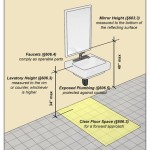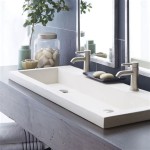What Is a Sink Bathroom Vanity?
A sink bathroom vanity is a combination unit, typically consisting of a sink integrated into or mounted on top of a cabinet or countertop. This furniture piece serves both functional and aesthetic purposes in a bathroom. Functionally, it provides a basin for washing hands, face, and other personal hygiene tasks. Moreover, the cabinet or storage component offers space to keep bathroom essentials organized and out of sight. Aesthetically, bathroom vanities contribute significantly to the overall style and décor of the bathroom.
The versatility of sink bathroom vanities makes them a staple in modern bathroom design. These units are available in a vast range of sizes, styles, materials, and configurations, allowing homeowners and designers to select options that best suit their specific needs and preferences. From compact vanities ideal for small powder rooms to expansive double-sink vanities designed for master bathrooms, there is a vanity to accommodate virtually any space and design vision.
Beyond their practical and visual appeal, sink bathroom vanities also offer considerable convenience. By consolidating the sink and storage features into a single unit, they streamline the bathroom layout and maximize available space. This integration can be particularly beneficial in smaller bathrooms where every square inch counts. The enclosed storage helps keep countertops clear and clutter-free, creating a more organized and visually appealing environment.
Key Components of a Sink Bathroom Vanity
A comprehensive understanding of sink bathroom vanities necessitates examining the key components that constitute the unit. These components work in concert to deliver both functionality and aesthetic appeal. The primary components include the sink, the cabinet or base, the countertop (if applicable), and the hardware. Each component contributes uniquely to the overall design and utility of the vanity.
The Sink: The sink is the central functional element of the vanity. Sinks can be integrated directly into the countertop (integral sinks) or mounted on top of it (vessel sinks, undermount sinks, or drop-in sinks). The choice of sink style impacts both the visual character and the ease of maintenance of the vanity. Integral sinks offer a seamless and easy-to-clean surface, while vessel sinks can add a distinctive design element. Undermount sinks provide a clean, minimalist look and make countertop cleaning easier, while drop-in sinks are a more traditional and often more affordable option.
The material of the sink also plays a crucial role. Common sink materials include porcelain, ceramic, glass, stainless steel, and stone. Each material offers different aesthetic qualities, durability, and maintenance requirements. Porcelain and ceramic sinks are durable, easy to clean, and relatively inexpensive. Glass sinks can create a modern and elegant look but may require more careful cleaning to avoid water spots. Stainless steel sinks are highly durable and resistant to stains, making them a practical choice for high-use bathrooms. Stone sinks, such as granite or marble, offer a luxurious aesthetic but can be more porous and require sealing to prevent staining.
The Cabinet or Base: The cabinet or base of the vanity provides the structural support and storage space. Cabinets are typically constructed from wood, plywood, MDF (medium-density fiberboard), or metal. Wood cabinets offer a classic and durable option, but they require proper sealing and finishing to prevent moisture damage. Plywood is a more moisture-resistant alternative to solid wood, making it a suitable choice for bathroom environments. MDF is a cost-effective option that provides a smooth surface for painting or laminating. Metal cabinets offer a modern and industrial aesthetic and are highly durable and resistant to moisture.
The storage configuration of the cabinet can vary widely. Options include cabinets with doors, drawers, or a combination of both. Drawers are ideal for organizing smaller items, such as toiletries and grooming tools, while cabinets with doors provide ample space for storing larger items, such as towels and cleaning supplies. Some vanities may also include open shelving, which can be used for displaying decorative items or storing frequently used items.
The Countertop: Many sink bathroom vanities include a countertop that provides a surface around the sink. Countertops can be made from a variety of materials, including granite, marble, quartz, solid surface (such as Corian), laminate, and wood. Granite and marble countertops offer a luxurious aesthetic and are highly durable, but they require sealing to prevent staining. Quartz countertops are a popular choice due to their durability, low maintenance, and wide range of color options. Solid surface countertops are non-porous and seamless, making them easy to clean and resistant to stains. Laminate countertops are a cost-effective option that offers a wide range of colors and patterns. Wood countertops can add warmth and character to the bathroom, but they require sealing and regular maintenance to prevent water damage.
The Hardware: The hardware of the vanity includes the knobs, pulls, hinges, and other metal components that are used to operate the doors and drawers. The hardware can significantly impact the overall style and functionality of the vanity. Options include a wide range of finishes, such as chrome, brushed nickel, oil-rubbed bronze, and matte black. The choice of hardware should complement the overall style of the bathroom and provide a comfortable and ergonomic grip.
Types of Sink Bathroom Vanities
Sink bathroom vanities are available in a diverse array of types, each catering to specific spatial constraints, design preferences, and functional requirements. Understanding the different types of vanities available is crucial for making an informed choice. The primary types include freestanding vanities, wall-mounted vanities, corner vanities, and double sink vanities.
Freestanding Vanities: Freestanding vanities are the most common type of bathroom vanity. They stand on the floor and are typically supported by legs or a solid base. Freestanding vanities are easy to install and offer ample storage space. They are available in a wide range of styles, sizes, and materials, making them a versatile choice for various bathroom designs. Freestanding vanities are also relatively easy to replace or update, as they do not require any structural modifications to the bathroom.
Wall-Mounted Vanities: Wall-mounted vanities, also known as floating vanities, are mounted directly to the wall, leaving the space underneath the vanity open. This type of vanity creates a clean and modern look and can make the bathroom appear more spacious. Wall-mounted vanities are particularly well-suited for smaller bathrooms or bathrooms with limited floor space. They also make cleaning the floor underneath the vanity easier. However, wall-mounted vanities require careful installation to ensure that they are securely attached to the wall. It's important to verify that the wall can support the weight of the vanity and its contents.
Corner Vanities: Corner vanities are designed to fit into the corner of a bathroom, making them an ideal choice for small or irregularly shaped bathrooms. They maximize the use of available space and can help to create a more functional layout. Corner vanities are available in a variety of styles and materials, allowing them to be integrated seamlessly into different bathroom designs. However, the storage capacity of corner vanities may be limited compared to other types of vanities.
Double Sink Vanities: Double sink vanities feature two sinks side-by-side, making them a convenient choice for master bathrooms or bathrooms shared by multiple users. They provide ample space for two people to use the sinks simultaneously, reducing the likelihood of conflicts and enhancing convenience. Double sink vanities are available in a range of sizes and styles, allowing them to be adapted to different bathroom layouts and design preferences. However, they typically require a larger bathroom to accommodate their larger size.
Factors to Consider When Choosing a Sink Bathroom Vanity
Selecting the right sink bathroom vanity involves careful consideration of several factors. These factors include the available space, the desired style, the storage needs, the budget, and the plumbing configuration. Weighing these factors will help to ensure that the selected vanity meets the functional and aesthetic requirements of the bathroom.
Available Space: The size of the bathroom is a primary factor to consider when choosing a vanity. Measure the available space carefully and select a vanity that fits comfortably without overcrowding the room. Consider the depth of the vanity as well as its width. In smaller bathrooms, a compact vanity or a wall-mounted vanity may be the best option. In larger bathrooms, a double sink vanity or a larger freestanding vanity may be more appropriate.
Desired Style: The style of the vanity should complement the overall design of the bathroom. Consider the existing color scheme, materials, and architectural style. Vanities are available in a wide range of styles, from traditional to modern to rustic. Choose a vanity that reflects your personal taste and enhances the overall aesthetic of the bathroom. Pay attention to details such as the hardware, the countertop material, and the cabinet finish.
Storage Needs: Assess your storage needs before selecting a vanity. Consider the types of items that you need to store in the bathroom, such as toiletries, towels, and cleaning supplies. Choose a vanity with a storage configuration that meets your specific needs. Drawers are ideal for organizing smaller items, while cabinets are better suited for larger items. Open shelving can provide additional storage or display space.
Budget: Sink bathroom vanities are available in a wide range of price points. Establish a budget before you start shopping and stick to it. Consider the cost of the vanity itself, as well as the cost of installation and any necessary plumbing modifications. Remember that higher-quality vanities may be more expensive upfront but can offer better durability and longevity in the long run.
Plumbing Configuration: The existing plumbing configuration of the bathroom will influence the type of vanity that can be installed. Consider the location of the water supply lines and the drainpipe. If you are replacing an existing vanity, try to choose a new vanity that is compatible with the existing plumbing connections. If you are installing a new vanity in a new location, you may need to hire a plumber to modify the plumbing configuration.
By taking into account these key factors, individuals can confidently select a sink bathroom vanity that not only enhances the functionality and organization of their bathroom but also complements its overall design.

Bathroom Vanity Styles To Fit Your Space Forbes Home

Bathroom Vanities The Home Depot

31 Black White Floating Bathroom Vanity Faux Marble Top Ceramic Vessel Sink Homary
How To Measure A Vanity Sink Bathroom Dimensions Standard Size Vevano

16 Single Sink 48 Inch Bathroom Vanities Kelley Nan

New This Week 5 Stylish Single Sink Bathroom Vanity Areas

Project Source 36 In Gray Single Sink Bathroom Vanity With White Cultured Marble Top The Vanities Tops Department At Com

35 Best Bathroom Vanities 2024

What Types Of Bathroom Vanity Materials Should You Use Newsnews

For Bathroom Vanities Vanity Sets Modern
Related Posts







